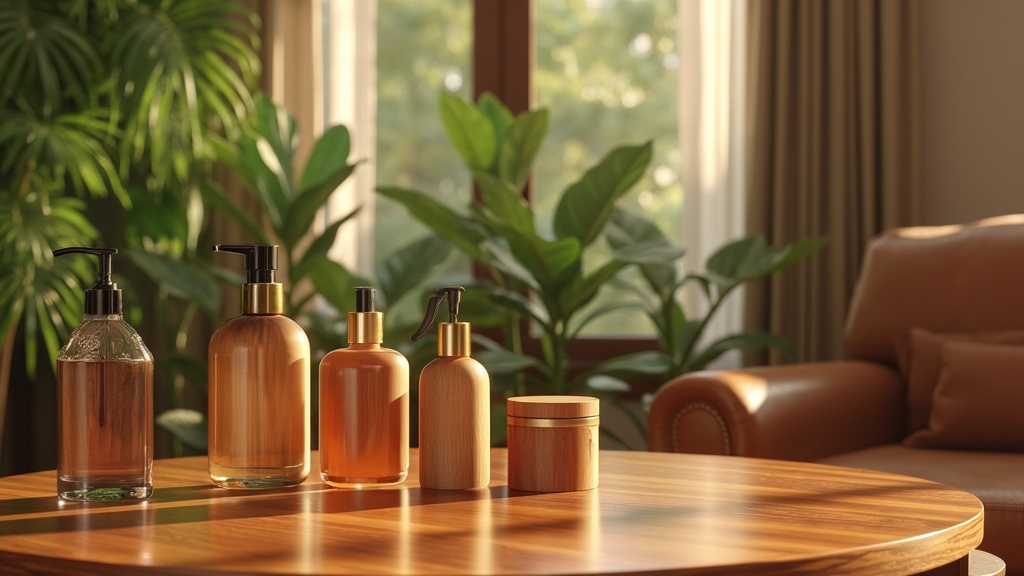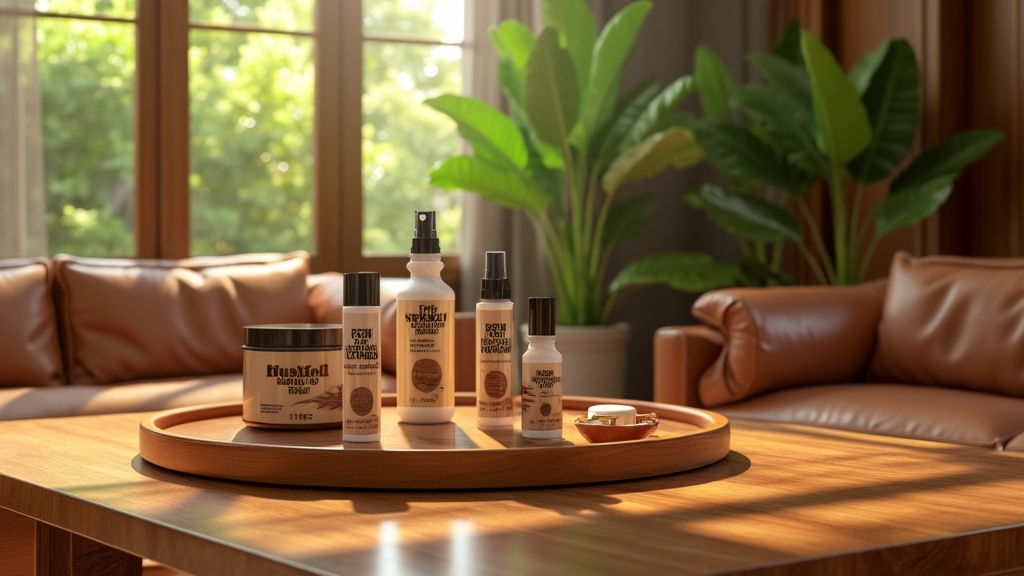The correct choice of wood polish is essential for preserving the beauty and longevity of your furniture. Using a quality wood care product enriches the aesthetic while providing protection against everyday wear and tear.
Many individuals are unaware that not all wood polishes share the same composition, which can lead to ineffective care techniques.
Selecting the right polish can noticeably extend the life of wooden items, particularly valuable antiques.
A reliable product will not only enhance shine but will also act as a robust moisture barrier, ensuring comprehensive wood preservation.
Click here to learn more about: how to polish wood
Choosing The Right Wood Polish
Determining the ideal wood polish requires careful consideration of several factors. Variables such as wood type, furniture age, and the frequency of usage impact the polish’s effectiveness.
For example, an ecofriendly polish containing natural ingredients is excellent for households with children and pets. On the other hand, a wax polish provides a durable finish that significantly enhances shine for antique pieces.
Each polish type serves different purposes and can be selected based on specific needs.
Types of Wood Polish
Different wood finish types include beeswax, carnauba wax, and liquid polish.
For example, beeswax is an excellent option for its protective properties, while carnauba wax offers a high-gloss finish that appeals to many.
Additionally, cream polish is a great choice for quick application and results without sacrificing quality. Restoration polish can help revive dull surfaces and is perfect for furniture maintenance.
Testing for Compatibility
Before applying any wood polish, conducting a test area application on a small, inconspicuous section of your furniture is highly recommended.
This initial step allows for checking finish compatibility and ensures that the chosen product will not cause damage, thereby facilitating a successful maintenance routine. If results are satisfactory, proceed with application to enhance furniture longevity.

Benefits Of Natural Polish
Natural polishes present a variety of advantages that resonate with modern sustainability practices. For instance, ecofriendly polish options are biodegradable, which significantly reduces our ecological footprint.
Many natural ingredients originate from renewable resources, promoting a healthier planet.
These natural polish varieties often feature reduced toxicity compared to their synthetic counterparts, which contributes to enhanced indoor air quality and minimizes allergic reactions.
Statistics indicate that a substantial number of individuals experience sensitivities to chemical-laden products, making the switch to natural solutions beneficial for overall health. A practical example is this homemade natural polish recipe: combine one part olive oil with one part vinegar in a spray bottle, and apply it using a clean cloth.
Natural polishes not only beautify wood but also nourish it, ensuring durability and safety for families and pets.
“Nourishing wood with natural ingredients fosters both beauty and longevity. ”
Ecological Advantages
Switching to natural polish options provides considerable ecological benefits.
These polishes reduce pollution and support biodiversity through the use of nontoxic formulas.
Choosing products made from renewable resources further eliminates harmful synthetic chemicals and promotes sustainable practices in furniture maintenance.
Health Benefits
Using natural polishes can lead to improved indoor air quality. Unlike conventional polishes that emit volatile organic compounds (VOCs), these ecofriendly alternatives lower the risk of respiratory issues and skin sensitivities, creating a safer environment for children and pets.
How To Apply Cream Polish
Applying cream polish effectively enhances the aesthetics of your furniture. To ensure successful application, first gather essential tools such as soft cotton cloths, your chosen cream polish, and a soft-bristle brush if necessary.
Start by thoroughly cleaning the wood surface to eliminate dust and dirt.
Subsequently, take a clean, dry cloth and apply a small amount of cream polish.
It is imperative to polish in the direction of the wood grain to prevent any potential damage. Apply moderate pressure in a circular motion to distribute the polish evenly.
“Always work in the direction of the grain for optimal results. ”
Allow the cream polish to rest for a few minutes before buffing with another clean cloth. Following these steps will not only create a beautiful finish but also contribute to the longevity and aesthetic appeal of your furniture.
Tools Needed
The proper tools significantly impact the success of your wood care routine.
Ensure you have soft cotton cloths and quality cream polish on hand to facilitate an effective application process.
Technique for Application
Utilizing effective polishing techniques during application will enhance the results. Always test a small area before proceeding to ensure compatibility with the finish type, which can prevent potential issues with damage or discoloration.
.
| Benefit | Description |
|---|---|
| Ecological Impact | Biodegradable and made from renewable resources, reducing ecological footprint. |
| Toxicity Reduction | Lower toxicity compared to synthetic polishes, improving indoor air quality. |
| Health Benefits | Minimizes risk of respiratory issues and skin sensitivities for families and pets. |
| Application Technique | Polishing in the direction of the grain ensures optimal results and prevents damage. |
Wax Polish Types
Choosing the right wax polish significantly affects the aesthetics and durability of wooden furniture. A variety of wax options are available, including natural types like beeswax and carnauba wax, each tailored for specific applications.
Natural waxes provide deep conditioning and a rich finish, thereby enhancing wood’s natural grain.
Conversely, synthetic waxes can offer enhanced durability and moisture resistance, making them ideal for high-traffic areas.
Periodic waxing not only preserves the wood’s shine but also establishes a barrier against dirt and environmental damage, thus ensuring your furniture’s longevity.
Natural Wax Options
Natural waxes, such as beeswax, are celebrated for their wood preservation properties. They imbue a natural shine enhancer to the surface, highlighting the intricate grain patterns within various wood finish types.
Carnauba wax, derived from the leaves of a Brazilian palm, is known for providing a high-gloss finish that is durable and resistant to water.
Synthetic Wax Variants
Synthetic waxes are formulated to deliver protection against wear while maintaining a pleasing aesthetic. These waxes often incorporate conditioning agents that improve furniture longevity and facilitate easier application.
Their quick-drying options make them a favorite for those needing efficiency without sacrificing quality.
Furniture Maintenance Tips
Establishing a routine furniture maintenance plan is essential for extending the life of wooden items.
Regularly dusting with a microfiber cloth is important, as it prevents scratches and eliminates contaminants that could harm the finish.
Utilizing a quality natural polish also aids in protecting the wood’s surface from moisture and UV light.
Seasonal Care Checklist
Maintaining a seasonal checklist can greatly enhance furniture longevity. During spring cleaning, inspect for damage and address any concerns promptly.
In the fall, applying a protective moisture barrier ensures that your furniture is ready to withstand changing environmental conditions.
Daily Maintenance Practices
Incorporating simple daily practices, such as using an appropriate application cloth or a spray applicator for polishes, can keep surfaces looking pristine. Avoid placing furniture in direct sunlight to protect finishes and help maintain the furniture aesthetic.
These consistent efforts contribute significantly to shine restoration and overall wood enhancement.
Wax Polish and Furniture Maintenance
- Natural waxes like beeswax and carnauba wax enhance the wood’s natural grain and provide a deep conditioning effect.
- Synthetic waxes often include conditioning agents that improve furniture longevity and facilitate easier application.
- Regular dusting with a microfiber cloth prevents scratches and removes contaminants that can harm the wood finish.
- Applying a protective moisture barrier in the fall prepares furniture for changing environmental conditions.
What Is A Moisture Barrier?
A moisture barrier protects wood from moisture-related damage through a dedicated layer designed to prevent water intrusion. This layer typically consists of materials such as polyethylene, asphalt, or specialized coatings.
Effective moisture barriers significantly reduce the risk of mold and mildew, which thrive in damp environments and can lead to substantial degradation of wooden surfaces.
To achieve optimal effectiveness, install moisture barriers in high-humidity areas, such as basements and bathrooms.
Ensure that all joints and edges are properly sealed, providing the best protection against moisture intrusion.
Enhancing Wood Grain Effectively
Highlighting wood grain visibility requires specific techniques aimed at showcasing the beauty of wooden surfaces. Approaches like staining and oiling not only emphasize the natural patterns but also offer protection to the wood.
For instance, using a beeswax-based natural polish serves as an effective means to enhance grain patterns while providing a durable finish. Certain woods, such as oak and walnut, display their grain more dramatically when treated with these finishes.
Implementing these methods can significantly improve the furniture aesthetic while ensuring lasting beauty and safeguarding the wood against wear and tear.
Moisture Barriers and Wood Treatment
- Moisture barriers can reduce the risk of mold and mildew by up to 90% in damp environments.
- Using a moisture barrier in basements can prevent wood rot and extend the life of wooden structures.
- Staining and oiling can enhance wood grain visibility while providing a protective layer against moisture and wear.
- Beeswax-based polishes can add a durable finish that enhances the natural beauty of woods like oak and walnut.
Evaluating Ecofriendly Polish Options
Choosing the right ecofriendly polish requires an examination of sustainable and responsible choices. Evaluating various products involves assessing ingredient transparency alongside certification standards.
Ecofriendly polishes are typically composed of natural ingredients that enhance wood preservation while minimizing environmental impact.
Clarifying the criteria for selecting these polishes ensures informed decisions during your furniture maintenance routine.
Criteria for Selection
Key criteria to consider include certifications such as USDA Organic or Green Seal, which signify adherence to eco-friendly practices.
Some polishes may still contain harmful substances even if labeled otherwise; therefore, always scrutinize ingredient lists thoroughly. An excellent resource is a comparison guide, which can facilitate the identification of the optimal ecofriendly polish that aligns with your values and wood care requirements.
Comparison Guide Insights
This guide should feature aspects like performance insights, customer feedback, and the frequency of use.
By utilizing polish reviews, you can assess the effectiveness of various products, including liquid polish, wax polish, and other wood finish types. Consider factors such as application methods, including application cloths or spray applicators, and the suitability of polishes for different wood types like oak, cherry, and walnut.
As you delve into the specifics of each product, pay attention to unique features such as moisture barriers, dust protection, and UV protection.
These properties are essential for enhancing furniture longevity and aesthetics.
Formulations that include conditioning agents can also play a pivotal role in ensuring a high-gloss finish or a natural matte finish depending on your preferences.
Ultimately, the right ecofriendly polish will not only provide shine restoration but also adhere to your commitment to sustainable practices in home maintenance.
Engaging with a comparison guide empowers you to choose polishes that fulfill your requirements for both performance and environmental stewardship.
| Criteria for Selection | Details |
|---|---|
| Certifications | USDA Organic, Green Seal |
| Ingredient Transparency | Thoroughly scrutinize ingredient lists |
| Unique Features | Moisture barriers, dust protection, UV protection |
| Wood Types Compatibility | Suitable for oak, cherry, walnut |
How To Polish Wood Furniture Effectively
Wood Polishing Techniques For Lasting Beauty


